Top News
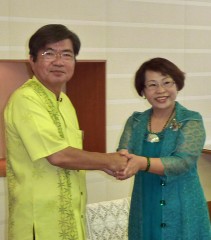
July 22, 2011 Ryukyu Shimpo
On July 21, a delegation from the Tainan City Council, Taiwan, visited the Okinawa Prefectural Assembly to meet with its chairman Zenshin Takamine. Both parties confirmed that they will promote exchange in the fields of economics, specifically focusing on agriculture.
Council Speaker Lai Mei-hui said, “We have an active agricultural sector in Tainan, including mango farming. Okinawa and Tainan have similar climates. We want to deepen cooperation with Okinawa, in the agricultural sector and in terms of economic activity in general.”
Chairman Takamine said, “Numbers of tourists from Taiwan have decreased considerably. We request that you let people know that Okinawa is a beautiful place and a safe destination.”
The Taiwanese delegation consisting of 23 people including 11 city council members and other staff stayed two nights in Okinawa from July 19.
During their visit, they planned to visit Kadena U.S. military Air Base, Shuri Castle among other places. A delegation representing the Okinawa Prefectural Assembly will visit Taiwan in August and members of both these delegations exchanged opinions in the assembly office.
(English Translation by T&CT, Mark Ealey)
Go To Japanese
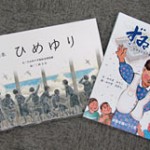
July 20, 2011 Eriko Tamaki of Ryukyu Shimpo
Two picture books have been published that tell the story of female high school students who joined nursing units in the Imperial Japanese Army during the Battle of Okinawa. They are the Himeyuri Picture Book (Himeyuri Alumnae Incorporated Foundation) and Zuisen – Female students at the Frontline (Okinawa Retired School Personnel Association Women’s Group).
A spokesperson for the project said, “We hope that the picture books will help promote discussion of the Battle of Okinawa within people’s homes.”
While the number of people who experienced the Battle of Okinawa is decreasing, the publishers hope that those who did not experience the battle could use these picture books to educate children about the war.
The power of a picture book
Although the Himeyuri Picture Book was sold only in the Himeyuri Peace Museum, it sold 300 copies on its first day.
What is different from in the past is that the book has stimulated a great deal of reaction from within the prefecture. Many teachers and parents praise the book, saying, “We would like to read it to our children and pupils.”
Thirty-four year-old Akiko Nakada, who works for the museum, said, “To be honest, I did not expect that there would be such a huge reaction. It makes me realize that people want things that are easily understandable.”
Since it opened in 1989, the Himeyuri Peace Museum has continued to emphasize the cruelty of wartime education that encouraged students to sacrifice themselves on battlefields, and also the preciousness of peace.
In 2004 the museum changed its displays so they do not need to be explained by those who have experienced the Battle of Okinawa, but it was still difficult for children to understand battlefield terminology such as “unassisted patients” or “Army Hospital.”
Eighty-three year-old Yoshiko Shimabukuro, the director of the museum, hopes to see benefits from the picture book, saying, “The book depicts the Battle of Okinawa in simple terms, making children read it again and again. People always remember books they read during their childhood.”
The staff of the museum considered pictures drawn by the artist and painter, Keisuke Mita for the Himeyuri Picture Book.
Fifty-one year-old Chokei Futenma, the head of curatorial office of the museum emphasized that during the book’s production process people who have never experienced wars inherited the memories of the Battle of Okinawa from those who have experienced it, saying “People from different backgrounds worked together and sifted through the relevant historical facts.”
How to convey the cruelty of the war
When a former female high school student who worked for the Imperial Japanese Army during the Battle of Okinawa talked to a group of elementary school students in the prefecture, she was faced with questions from the pupils such as, “How many people can start a war?” “When do people who get shot, get back up again?”
Survivor of the Zuisen Students, 85 year-old Michiko Miyagi, was shocked at this episode, saying, “Wars exist only on television for these children. They cannot imagine that the Battle of Okinawa actually happened in the past.”
Based on a collection of notes written by Miyagi and published in 2002, Okinawa Retired School Personnel Association Women’s Group created the picture book, Zuisen.
Seventy-one year-old Noriko Noguni, the director of the group, said, “We selected the scenes it depicts based on aspects of the cruelty of war, trying to make children actually understand the experiences in the Battle of Okinawa. For example, things like the pain for students when their friends were killed and seeing their schools gradually becoming militarized. These days, there are even children whose grandparents did not experience the war. We would like adults to read the picture book to their children and hope that both generations deepen their understanding of the war.”
(English Translation by T&CT, Mark Ealey)
Go To Japanese
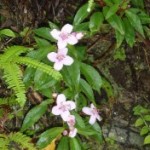
July 20, 2011 Ryukyu Shimpo
Nago City resident Toshiko Miyagi recently confirmed that the endangered species Kashinokiran or Gastrochilus japonicus, which is on the vulnerable (VU) category II Red List of the Ministry of the Environment and the Okinawa Prefectural Government, and Kobanomiyama botan or Bredia Okinawensis (vulnerable species of the same Red List) were in both bloom in the northern mountain area of the main island of Okinawa.
In recent years, these precious flowers have been depleted through over picking and development. They are now showing their pretty form quietly in the mountains of the Yanbaru.
Because it grows on the trunk of tall trees, Kashinokiran is rarely seen by the human eye. Its flower is also small – less than one centimeter in size.
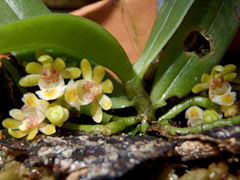
Kashinokiran’s lovely little flowers are pleasing to the eye of people in the mountains of the northern area of the main island.
is a shrub of no more than one meter in height, which has flowers just a few centimeters across. It is endemic in the northern area of Okinawa’s main island. Dam construction has caused some parts of its habitat to disappear under water.
(English Translation by T&CT, Mark Ealey)
Go To Japanese
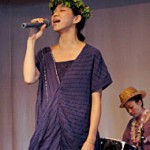
July 19, 2011 Naoki Isa
Japanese singer-songwriter UA gave a small concert at the debriefing session held at a farmer training facility in Higashi Village on the occasion of the fourth anniversary of the commencement of the sit-in protest by the “Residents Association Against the Helipad Construction.”
Familiar with the area because a friend of hers used to live in Takae, Higashi Village, UA sides with those protesting against the construction of new helipads in the Yambaru forest, the mountainous region in the northern part of Okinawa which surrounds Higashi Village. The region is known for its distinctive and highly valuable biodiversity.
The U.S. government intends to build six helipads in this natural forest area.
Despite being pregnant, UA sang songs including prayers for harmony with nature and a world without military bases.
UA adores and feels a sense of familiarity towards Okinawa since her mother is from Amami Islands, which were originally part of the Ryukyu Islands, but currently belong to Kagoshima Prefecture.
Concerned about radiation fallout from the Fukushima Daiichi nuclear disaster, UA moved from Kanagawa Prefecture to the Yambaru with her family in April.
UA started the concert by singing Teada Nu Uchiti Maguri Bushi (The last minute when the sun goes down), a folk song from the Amami Islands.
The song, reminiscent of ancient prayers, took the audience back to the era when humans, nature and gods were all intimately connected.
She sang an original song titled “Moor” which tells the story of “6500 million ants living on Spaceship Earth.” In the song, ants do not realize that the spaceship is about to fall into a water pocket.
Tonchi, a steel pan player from Tokyo who participated in the concert, supported the musical performance with some magical sounds.
UA said, “There may not be any nuclear power plants in Okinawa, but U.S. military bases cause all sorts of problems here. I will have a new baby soon. What am I going to say to my child when the Osprey aircraft fly overhead? It’s really painful for me to have to explain to my children that people distrust each other, and are training and preparing to fight wars.”
On that same night at the exchange gathering held in front of the helipad construction site, UA sang “My baby,” the cover song of singer-songwriter Nanao Tabito.
The lyrics of the song say, “Full of happiness. Give us the world’s blessing here. All gather together tonight. My baby has arrived.”
UA’s baby is due this August. Her gentle voice with its lullaby tone, the sounds of the steel pan and the singing of insects all blended in, melting into the forest.
(English Translation by T&CT, Mark Ealey)
Go To Japanese
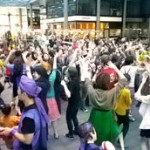
July 18, 2011 Emiko Morita correspondent of Ryukyu Shimpo
The 3rd Okinawa Day, sponsored by the Okinawa Sanshin Association of London and the Okinawa Kenjin-Kai of the United Kingdom, was held in Spitalfields, in central London on June 25. According to a spokesperson for the Executive Committee, 8000 participants enjoyed displays of Okinawan culture, including eisa dance, folk songs, Ryukyuan classical court music and dance, karate and cuisine. Yuka Takara, a singer originally from Okinawa, gave a live performance, and ceramic works and paintings by Okinawan artists in the United Kingdom and Okinawa were also exhibited and sold.
Kochinda Atelier, Ryuka Corporation and other companies participated and showed off products with an Okinawan flavor, including indigo dyed eco-bags and bingata dye-works.
Kenjin-Kai sold examples of Okinawan cuisine, and Reina Ward, who is originally from Naha City, and was responsible for the Okinawan cuisine, including andansu (oil and miso paste) and chinskou cake, said, “I am very happy. Okinawan food and sweets were very popular with people from many different countries. They were very interested in the cuisine, and asked me many questions about recipes.”
Local person Rebecca Mitchell said, “I came down to have a look because my son learns karate at a dojo. I am now interested to know that Okinawa has many great cultural features in addition to karate. We enjoyed the kachashi dance with everyone getting involved and being enthusiastic right to the end. I was moved that we seemed to all get on the same wavelength.”
(English Translation by T&CT, Mark Ealey)
Go To Japanese
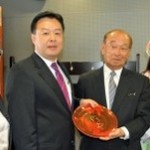
July 16, 2011 Sakae Toiyama of Ryukyu Shimpo
With the introduction of multiple-entry visas for Chinese tourists, the Governor of Okinawa Prefecture, Hirokazu Nakaima, and a support group visited Beijing on July 15 to carry out a public relations campaign for Okinawa tourism. They called at the Civil Aviation Administration of China, the National Tourism Administration, China’s leading airline companies, including Air China and Hainan Airlines, to promote the appeal of Okinawa, and requested an increase in the number of flights.
Air China, the largest airline in the country indicated that it had made application at the end of June to the authorities for twice weekly flights between Beijing and Naha. It will commence this service within the year at the earliest. China will launch non-stop flights from Beijing to Naha four times a week, adding the Air China service to the twice-weekly flights by Hainan Airlines that will start on July 28. The extended services by these leading Chinese companies are likely to help attract Chinese tourists to Okinawa.
Air China, which has about 40% of the landing and take-off rights at Beijing Airport in addition to being the largest national airline in the country, expects to be permitted to commence the new services.
Shi Zengqi, vice Chairman for Air China responsible for the sales stated, “Okinawa will be our seventh base of operations in Japan. We will flesh out our network within Japan through the route to Okinawa.” With regard to the timing of the start of its service, he said, “I am not sure, but we want to fly as soon as possible once we get permission from the government.” He suggested that it had dispatched its employees to study in Okinawa, and was preparing for the implementation of the service.
In that context, he has asked Governor Nakaima for assistance from the Okinawa Prefectural Government with regard to advertizing. The Governor responded, saying “Tell us what you need.”
Meanwhile, Hainan Airlines, the fourth-largest in China, has stated that it wants to go beyond two flights a week in future. The company asked the Governor to lighten the burden of landing fees and airport facilities fees. The Governor said that the OPG will carry out a study on potential supportive measures, including opening an office in Beijing.
(English Translation by T&CT, Mark Ealey)
Go To Japanese
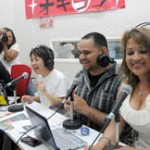
July 18, 2011 Teppei Ikeda of Ryukyu Shimpo
VacilOki, the first Spanish-language radio program in Okinawa, is gaining popularity.
It was started by Okiraji, a FM community radio station based in Okinawa City. The program’s four hosts, each with a different nationality, are attracting positive feedback as they provide various programs in which they invite Spanish-speaking people on as guests.
The radio hosts are Carolina Horikawa Yosa (from Peru), Lidibeth Rudy (from Panama), Manolo Matatan (from Dominica) and Francisco Figueroa (from Puerto Rico).
VacilOki streams live video over the Internet on its website.
The four hosts introduce recommended places in Okinawa and broadcast popular songs from their own countries.
The name VacilOki is a mixture of the Spanish word “vacilon” (fun loving) and “Okinawa,” in hope that many people will enjoy the radio service that started more than one month ago on June 8.
The program is streamed onto the Internet, so listeners are not confined to within the prefecture, with people from all around the world increasingly showing interest in Okinawa.
Carolina smilingly said, “We would like to make Spanish speaking people in Okinawa live happily and promote exchange between them and the local Okinawans. We would also like to spend more time introducing local specialties.”
(English Translation by T&CT, Mark Ealey)
Go To Japanese
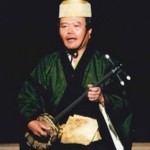
July 16, 2011 Ryukyu Shimpo
On July 15, the Cultural Affairs Council (headed by Suzuko Nishihara) recommended to Yoshiaki Takagi, the Minister of Education, Culture, Sports, Science and Technology that 70 year-old Kishun Nishie (originally from Iheya Village, but currently residing in Nakaima, Naha City), the head of Afuso Ryu Genseikai, a classical Okinawan music group, and the holder of the Kumi Odori Ongaku-uta Sanshin, one of the Important Intangible Cultural Properties, be nominated as a Living National Treasure.
There are three types of certification for holders of the Important Intangible Cultural Properties: individual certification, collective certification and preservation group certification.
Among the three types, generally only those who have received “Individual Certification,” the designation for individuals who “have attained high mastery” of an art or craft, are referred to as Living National Treasures.
Nishie is the 11th person in Okinawa to be designated as a Living National Treasure.
In the performing arts, he is the sixth person in the prefecture, following Masao Shimabukuro, Choichi Terukina in classical Ryukyuan music and the late Mitsufumi Shimabukuro in Kumi Odori Ongaku Taiko, Tokutaro Shiroma in Kumi Odori Ongaku-uta Sanshin and Noho Miyagi in Kumi Odori Tachikata.
On this occasion, Nishie and 67 year-old Kichiemon Nakamura (real name: Tatsujiro Namino), a Kabuki Tachiyaku residing in Tokyo, were newly recommended for the nomination.
Their nomination will be formally recognized when it is announced in a government gazette in late September.
With regard to the prefectural and city governments that have living national treasures who are still active, Tokyo has 49, Kyoto 14 and Ishikawa 9, followed by Okinawa, which has 8 ranking fourth in Japan.
Kumi Odori is a form of narrative traditional Ryukyuan dance. In Kumi Odori Ongaku-uta Sanshin, performers sing songs that explain the background behind each scene and the characters’ feelings in Kumi Odori, to the accompaniment of the sensitive sound of the Okinawa sanshin.
For instance, the singer starts to sing a song that overlaps with the end of a dialogue delivered by an actor or actress.
Making slight changes from one movement to the next, the singers sing songs matching the progression of the story, the acting and the dialogues.
A spokesperson of the Agency for Cultural Affairs said, “Nishie succeeded in skillfully embodying the traditional performance of Kumi Odori Ongaku-uta Sanshin after many years of practice. He is credited with powers of expression by which he could delicately sing songs imbued with meaning that depict both the characters’ feelings and the background to each scene in Kumi Odori. Nishie is also acclaimed for his elegant artistry and his sense of stability. He has worked hard to open a path for the young and to promote Kumi Odori.”
“I still have many things to learn”
Kishun Nishie says, “I still have many things to learn. This designation gives me the opportunity to start over from scratch. I would like to sing songs for Kumi Odori in various events or wherever the opportunity may arise. I feel enormous pressure and responsibility, and know that when I receive the ‘Individual Certification’ I will have to study accordingly.”
……………………………………………………………………………
Profile of Kishun Nishie: Born in Iheya Villege in 1940, in 1963 he studied classical Ryukyuan music under the late Haruyuki Miyazato of Afuso Ryu.
In 1996 Nishie was designated as the holder of Intangible Cultural Properties of Okinawa Prefecture for Okinawan classical dance. He was designated as the holder of classical Okinawan music Afuso Ryu in 1999.
Nishie was then designated as the holder of the Important Intangible Cultural Properties (collective certification) for Kumi Odori in 2001 and Ryukyu Buyo in 2009.
He worked as both an associate professor and professor at the Okinawa Prefectural University of Arts, contributing to the teaching of young people.
Nishie has been the executive director of Traditional Kumi Odori Preservation Society and the head of Afuso Ryu Genseikai from 2008.
(English Translation by T&CT, Mark Ealey)
Go To Japanese
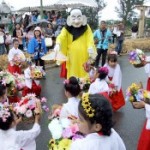
July 15, 2011 Ryukyu Shimpo
The harvest festival was held in the Ohama district, Ishigaki City, on July 9 and 10, offering prayers for a bountiful harvest both this year and next summer. Starting at Ohama, the Yaeyama regions have entered the harvest festival season. A diverse range of festivals will be held in all the districts towards the end of the month.
Murapuru Ohama Harvest Festival was held on July 10, in the square in front of the assembly house where the kantsukasa, or sacred women, came together throughout the utaki or the sacred sites. Residents dedicated their performances to the gods, including the bold standard-bearing by young men, iriku drums by Ohama Junior High School students, the miruku or maitreya parade accompanied by students of Ohama Elementary School and the song yoruame-bushi performed by the Women’s Club.
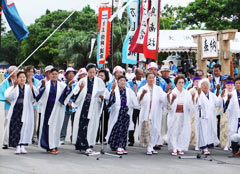
On July 10, kantsukasa and others sing the agari-bushi facing towards the sea to pray for a good harvest, at Ohama in Ishigaki City.
After making a dedication to the sacred place, the kantsukasa and representatives of the local community performed the agari-bushi or old song sung through the ages in the region. As the finale in the ceremony, they prayed for a good harvest in their dance, stretching their hands towards the sea to invite in the gods.
The festival has also been a great success with its entertainment, including song and dance performed by local residents. Many tourists came and took photographs of the display of traditional culture.
The director of Ohama Community Center Zensho Takamine said, “Ohama is a farming community. We were hit badly this year by typhoons and want to shed a bright light on the path ahead beyond the harvest festival.”
The harvest festival was held in Sakieda district on July 10.
(English Translation by T&CT, Mark Ealey)
Go To Japanese
July 15, 2011 Ryukyu Shimpo
Ishigaki Island was judged as the third best place in the world to dive for three consecutive years at the Dive & Travel Awards 2011, hosted by the Marine Art Center that publishes “Marine Diving,” a monthly diving magazine.
Ishigaki Island won the top spot in Japan for the 11th consecutive year.
The Yaeyama Diving Association (headed by Makoto Sonoda), which held a press conference at Ishigaki City Hall on July 14, announced the acceptance of the award.
Visitors to the Marine Diving Fair 2011, held from July 8 to 10 in Tokyo, and readers of “Marine Diving” voted for “Best Diving Area.”
Okinawa’s main island ranked sixth, followed by Miyako Island (seventh), Zamami Island (eighth) and Tokashiki Island (tenth). Five diving areas in Okinawa made it into the voters’ top 10.
Ishigaki Island was highly acclaimed for its beautiful underwater scenery and acceptance of and support for diving companies.
Ishigaki Island won 583 of the valid votes (8041).
The Maldives took the first place, followed by Palau, then Ishigaki and the Philippines.
(English Translation by T&CT, Mark Ealey)
Go To Japanese
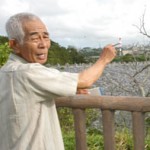
July 15, 2011 by Ryota Shimabukuro of Ryukyu Shimpo
On July 15, 40 years passed since phase II of the Red Hat Operation in which 13000 tons of poison gas munitions, including Mustard, Sarin and VX were removed from Okinawa to Johnston Island in the North Pacific Ocean. Residents never knew that these munitions had been stored in the U.S. Army Ammunition Depot Chibana. People living near the transfer passage from the Chibana Depot to Tengan Military Pier in Uruma City were evacuated for about two months until September 9, 1971 when the second round of transport was complete and lived lives of anxiety next to stocks of chemical weapons.
On December 3, 1970, an accident occurred in which employees complained of pain in their eyes and throats, and someone in the guard tower at Zukeyama Dam (now Kurashiki Dam) confirmed that white smoke was seen rising from the ammunition depot. This was just two days before the government announced phase I of the operation to transport the poison gas munitions.
“Has poison gas leaked?” 72 year-old Masao Nakasone, a member of the task force for residents of the Noborikawa district, shared his experience in those tense days. He said that while the U.S. military denied that there had been an accident involving poison gas, the residents were filled with anxiety and suspicion in the time ahead of the operation.
The U.S. military confirmed its poison gas storage in Okinawa for the first time after the Wall Street Journal reported that there had been a nerve gas leak at the Chibana Ammunition Depot in 1969.
A report written by Government of the Ryukyu investigators in 1971 speculated that since residents complained of eye pain, skin irritation, coughing and because of the inexplicable withering of plants people living near the bases from the 1960s were exposed to chemical weapons.
“The poison gas transfer operation was completed after a campaign against its storage by residents. We thought that we had resolved it at that time, but the ammunition depot is still there,” Nakasone said, 40 years later. He called for people to be wary of accidents, saying, “We do not know what will happen; the situation around us has not really improved.”
Nakasone is now editing a book on the history of the Noborikawa district in an attempt to prevent the facts of how the area was shrouded in fear in those days wearing thin.
(English Translation by T&CT, Mark Ealey)
Go To Japanese












 Webcam(Kokusai Street)
Webcam(Kokusai Street)


